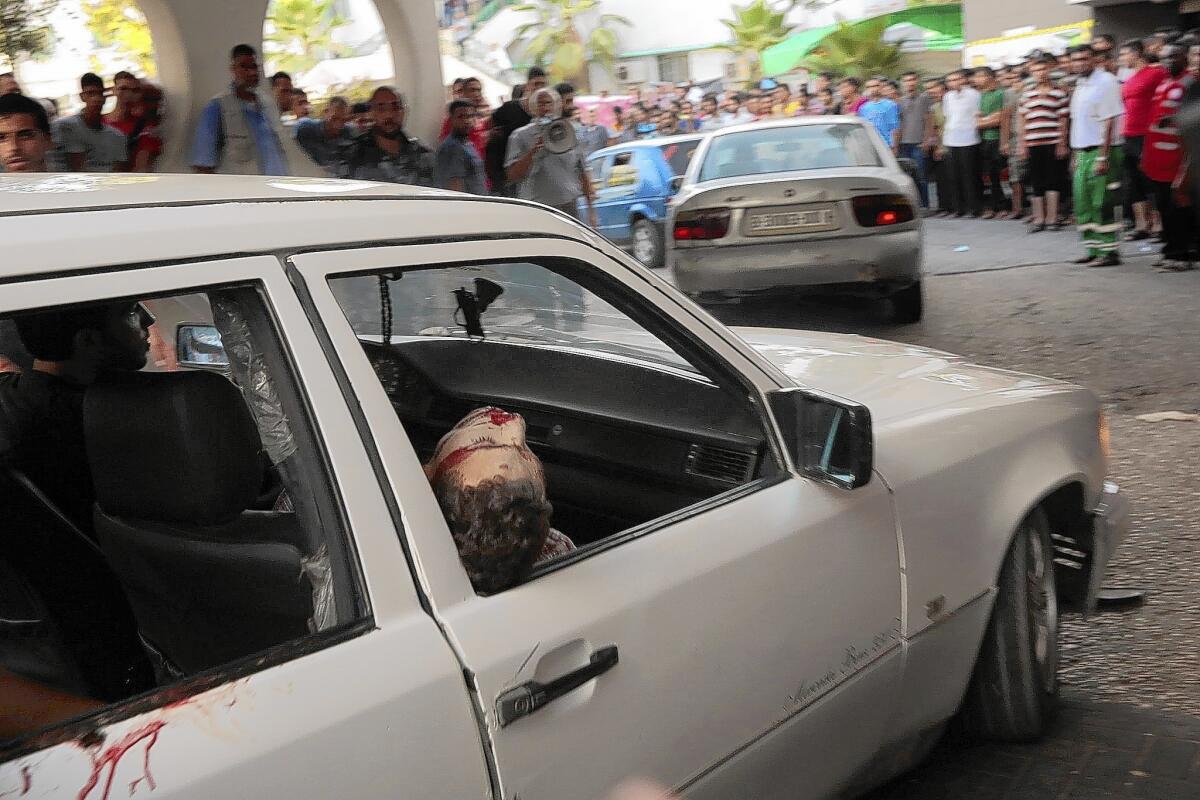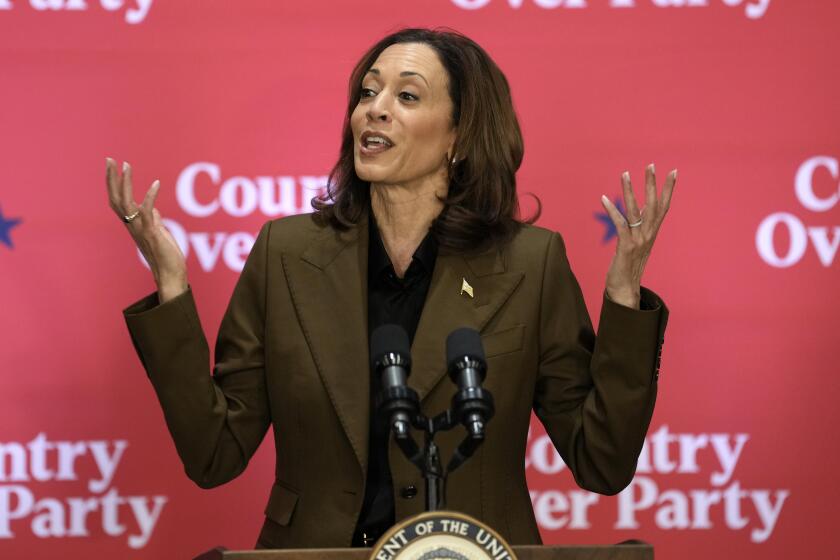Israeli strikes intensify; 16 killed at U.N. school-shelter in Gaza

Reporting from Jabaliya Refugee Camp, Gaza Strip — Most residents were asleep when the strikes started Wednesday at a United Nations school sheltering 3,300 Palestinians displaced by the war between Israel and the militant group Hamas.
Two shells slammed into classrooms packed with women and children, survivors said. Another hit a bathroom where men were performing their ablutions before dawn prayers. At least 16 people were killed and 90 injured, hospital officials said.
It was one of numerous deadly strikes Wednesday as Israel carried out some of the most intense bombardments of its 23-day-old offensive in the Gaza Strip. More than 130 people were killed in Israeli shelling throughout the narrow coastal enclave, raising the Palestinian death toll in the campaign to more than 1,340, said Ashraf Kidra, a Gaza health official.
The Israeli military also announced that three of its soldiers were killed while uncovering a tunnel in a home in southern Gaza. The house and tunnel were booby-trapped with explosives that detonated during the operation, it said in a statement.
At least 56 soldiers have been killed on the Israeli side, along with three civilians who died in mortar shelling and rocket fire from Gaza.
The heavy bombardments began late Tuesday, destroying the home of a top Hamas political leader and knocking out the enclave’s only electricity plant.
Most areas of Gaza were without power Wednesday. Worried residents lined up to buy fuel for generators and stock up on bread before bakery ovens lost power. Then another round of airstrikes sent them racing for cover.
The Israeli military said it targeted about 110 sites in Gaza on Wednesday, including at least five mosques it said were used by militants to conceal weapons, house tunnel shafts and serve as lookout posts.
With violence spiraling in Gaza, the Israel Defense Forces announced a four-hour cessation of hostilities beginning at 3 p.m. Wednesday to give rescue workers time to remove the dead and evacuate the injured, and to give civilians trapped in combat zones time to escape. But they said the “humanitarian window” would not apply to areas where troops were “active.”
Hamas spokesman Sami abu Zuhri dismissed the announcement as a “a media stunt,” saying the truce had no value because it excluded zones along the border with Israel, where wounded awaited evacuation.
In the hours after the unilateral truce took effect, 26 rockets were launched from Gaza toward Israel, two of which were intercepted by the country’s missile defense system over the cities of Ashkelon and Netivot, the Israeli military said.
In Gaza City, explosions thundered into the evening. Before Israel’s cease-fire ended, word came of shelling in a crowded shopping area on the east side of the city. Gaza health officials said at least 17 people had been killed and more than 200 injured in the strike on the edge of Shajaiya, which has been one of the most heavily bombarded neighborhoods in Gaza.
Ambulances streamed into the city’s main Shifa hospital, sirens wailing. Kamal Sawaf, 20, arrived with two injured cousins. One went into surgery, and the other was pronounced dead. He said the family was sitting in front of their house, watching the crowds mill about in the street, when the shelling started.
“Bombs were flying all over,” he said. “All I could see were feet and other body parts all over the place.... Everything was shaking, and I thought I was about to die.”
Israel Defense Forces spokesman Brig. Gen. Motti Almoz said the military was investigating the incidents at the market and school. He told Israel’s Channel 2 television that the country had warned international organizations that Hamas had been firing at Israeli forces from such locations and that “the IDF will not endanger its troops” by not responding.
He and other Israeli officials accuse Palestinian militants of putting civilians at risk by operating among them.
Pierre Kraehenbuehl, commissioner-general of the United Nations aid agency for Palestinian refugees, said evidence collected at the school site indicated that it had been hit by Israeli artillery. Among the dead was a U.N. guard who was trying to protect the site.
“This is an affront to all of us,” Kraehenbuehl said in a statement. “The precise location of the Jabalia Elementary Girls School and the fact that it was housing thousands of internally displaced people was communicated to the Israeli army 17 times.”
He called on the international community to take action to bring the carnage to an end.
“This is the sixth time that one of our schools has been struck,” Kraehenbuehl said. “Our staff, the very people leading the humanitarian response, are being killed. Our shelters are overflowing. Tens of thousands may soon be stranded in the streets of Gaza, without food, water and shelter if attacks on these areas continue.”
More than 204,000 people have crammed into 85 schools operated by the U.N. Relief and Works Agency. The school hit Wednesday is in the Jabaliya refugee camp, a warren of narrow winding streets north of Gaza City and one of the most densely populated parts of the enclave.
Israel said it had dropped leaflets and sent recorded phone messages to residents Tuesday, urging them to evacuate. But many of those sheltering at the school said they did not receive the warnings, and in any case had nowhere to go.
Najwa abu Oda, 46, said shells destroyed her house in the northern town of Beit Hanoun, a focus of Israel’s campaign to dismantle rocket installations and destroy the cross-border tunnels.
She said she had hoped her family would be safe at a nearby U.N. school. But the facility was hit by a series of explosions last week, killing at least 16 people sheltered there. So they moved south, to the school in Jabaliya, she said.
Her 16-year-old son and a son-in-law were sleeping in the courtyard when shells crashed into the school early Wednesday, she said. Both were rushed to a hospital with shrapnel wounds.
Hours later, the rest of the family remained huddled at the edge of the courtyard, as journalists and dazed survivors surveyed the damage. They had no plans to leave, Abu Oda said.
“Where do they want us to go?” she asked. “We have no other place.”
Near the entrance of the school, Atif Warshargha, 40, rummaged through blood-soaked clothes and upended furniture to salvage what he could from a ruined classroom.
He said he had left his wife and two children at the school overnight while he worked at a city government office. They were sleeping on the classroom floor when a shell tore through the wall. He had just returned from visiting them at a hospital.
“I still don’t know where we’re going to go now,” he said as he hurried out the gate, carrying a battered cardboard box with a few items of children’s clothing.
Around him, people started pointing at the sky. White fliers fluttered toward them. They hurried to pick them up.
“The IDF is moving to the next stage of the operation,” they warned. “Residents of these areas must be aware because this is where we will operate.”
Special correspondents Batsheva Sobelman in Jerusalem, Ahmed Rezeq in Gaza City and Maher Abukhater in Ramallah, West Bank, contributed to this report.
More to Read
Sign up for Essential California
The most important California stories and recommendations in your inbox every morning.
You may occasionally receive promotional content from the Los Angeles Times.











